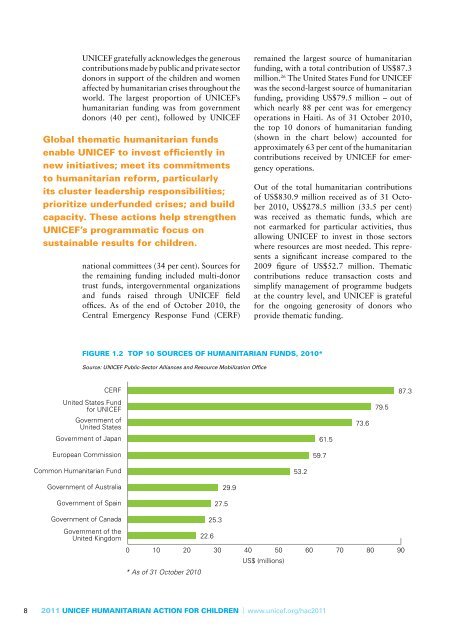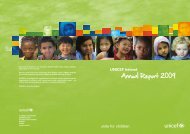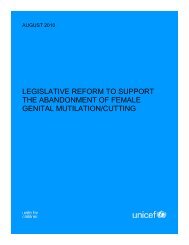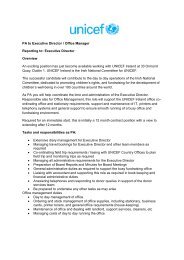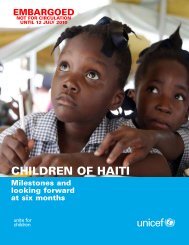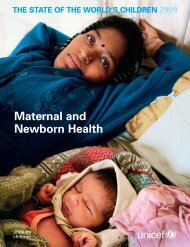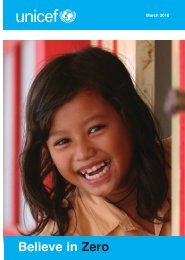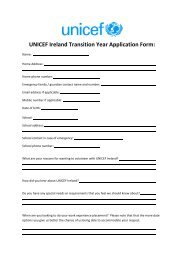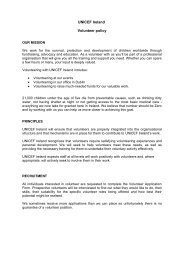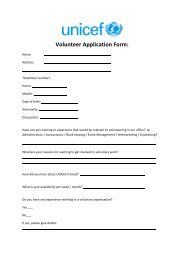UNICEF gratefully acknowledges the generouscontributions made by public and private sectordonors in support of the children and womenaffected by humanitarian crises throughout theworld. The largest proportion of UNICEF’shumanitarian funding was from governmentdonors (40 per cent), followed by UNICEFGlobal thematic humanitarian fundsenable UNICEF to invest efficiently innew initiatives; meet its commitmentsto humanitarian re<strong>for</strong>m, particularlyits cluster leadership responsibilities;prioritize underfunded crises; and buildcapacity. These actions help strengthenUNICEF’s programmatic focus onsustainable results <strong>for</strong> children.national committees (34 per cent). Sources <strong>for</strong>the remaining funding included multi-donortrust funds, intergovernmental organizationsand funds raised through UNICEF fieldoffices. As of the end of October 2010, theCentral Emergency Response Fund (CERF)remained the largest source of humanitarianfunding, with a total contribution of US$87.3million. 26 The United States Fund <strong>for</strong> UNICEFwas the second-largest source of humanitarianfunding, providing US$79.5 million – out ofwhich nearly 88 per cent was <strong>for</strong> emergencyoperations in Haiti. As of 31 October 2010,the top 10 donors of humanitarian funding(shown in the chart below) accounted <strong>for</strong>approximately 63 per cent of the humanitariancontributions received by UNICEF <strong>for</strong> emergencyoperations.Out of the total humanitarian contributionsof US$830.9 million received as of 31 October2010, US$278.5 million (33.5 per cent)was received as thematic funds, which arenot earmarked <strong>for</strong> particular activities, thusallowing UNICEF to invest in those sectorswhere resources are most needed. This representsa significant increase compared to the2009 figure of US$52.7 million. Thematiccontributions reduce transaction costs andsimplify management of programme budgetsat the country level, and UNICEF is grateful<strong>for</strong> the ongoing generosity of donors whoprovide thematic funding.Figure 1.2 Top 10 sources of humanitarian funds, 2010*Source: UNICEF Public-Sector Alliances and Resource Mobilization OfficeCERFUnited States Fund<strong>for</strong> UNICEFGovernment ofUnited StatesGovernment of JapanEuropean Commission61.559.773.679.587.3Common <strong>Humanitarian</strong> Fund53.2Government of AustraliaGovernment of Spain27.529.9Government of CanadaGovernment of theUnited Kingdom25.322.60 10 20 30 40 50 60 70 80 90US$ (millions)* As of 31 October 20108 <strong>2011</strong> UNICEF <strong>Humanitarian</strong> <strong>Action</strong> FOR CHILDREN | www.unicef.org/hac<strong>2011</strong>
UNICEF would especially like to acknowledgenational committee partners, which haveprovided more than 90 per cent of thematicfunding received as of the end of October. TheUnited States Fund <strong>for</strong> UNICEF was the topthematic donor, with a contribution of US$72million, followed by the United KingdomCommittee <strong>for</strong> UNICEF, the GermanCommittee <strong>for</strong> UNICEF, the Japan Committee<strong>for</strong> UNICEF and the Canadian UNICEFCommittee, as seen in the chart below.While the 2010 level of thematic funding ismuch higher than the 2009 level, an analysisof the recipients highlights that so far in 2010,more than 90 per cent of the thematic fundswere provided <strong>for</strong> response to the Haiti earthquakeand the Pakistan floods. Only US$27.6million was provided <strong>for</strong> the remaining countriesand regions. UNICEF continues to urgedonors to provide flexible humanitarianfunding <strong>for</strong> all countries, particularly at theglobal level. Next to regular resources, globalthematic funding is UNICEF’s preferred fundingstructure. However, only 0.7 per cent ofthe thematic humanitarian funds receivedin 2010 were provided as global thematichumanitarian funds. Global thematic fundingis the most effective option because it allowsUNICEF to respond strategically to thepriority needs of children worldwide. Globalthematic humanitarian funds enable UNICEFto invest efficiently in new initiatives; meetits commitments to humanitarian re<strong>for</strong>m, particularlyits cluster leadership responsi bilities;prioritize underfunded crises; and build capacity.These actions help strengthen UNICEF’sprogrammatic focus on sustainable results<strong>for</strong> children.The level of funding received determinesUNICEF’s capacity to help improve the prospectsand the resilience of children and womenaffected by sometimes multiple crises.In Yemen, with a funding level of 66 per centof the requested amount by the end of October,UNICEF, together with partners, treated morethan 11,000 children <strong>for</strong> undernutrition in32 outpatient treatment sites; provided accessto safe drinking water <strong>for</strong> more than 46,000internally displaced adults and children inthe northern governorates and 5,000 peoplefrom host communities; offered educationalopportunities to 125,000 children in conflictaffectedgovernorates; and provided psychosocialsupport <strong>for</strong> 3,500 vulnerable childrenfacing trauma associated with conflict anddisplacement.In Somalia, where 27 per cent of the populationrequires humanitarian assistance, fundingenabled UNICEF to provide 1.5 millionchildren under 5 years of age and 1.3 millionwomen of childbearing age with an essentialpackage of life-saving health and nutritionservices. Access to safe water was providedto 1.2 million people in emergency-affectedareas, and more than 92,000 emergencyaffectedchildren were enrolled in school.Figure 1.3 Top five Donors – Thematic <strong>Humanitarian</strong> Funds*Source: UNICEF Public-Sector Alliances and Resource Mobilization OfficeUnited States Fund<strong>for</strong> UNICEFUnited KingdomCommittee <strong>for</strong> UNICEFGerman Committee <strong>for</strong> UNICEFJapan Committee <strong>for</strong> UNICEF22.121.720.572.0Canadian UNICEF Committee15.50 10 20 30 40 50 60 70 80US$ (millions)* As of 31 October 2010www.unicef.org/hac<strong>2011</strong> | <strong>2011</strong> UNICEF <strong>Humanitarian</strong> <strong>Action</strong> FOR CHILDREN 9


